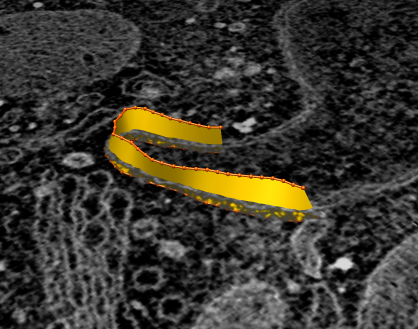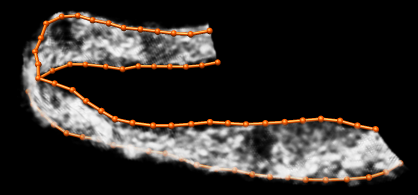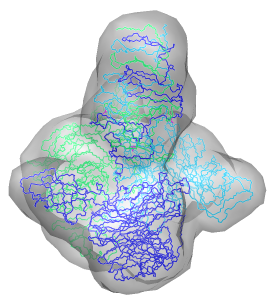Work in Progress
Tom Goddard
March 24, 2008
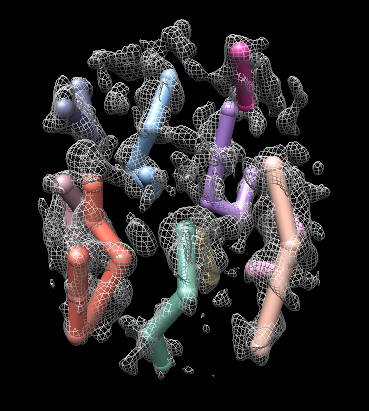
Influenza Tomography
Influenza virus tomography from Jack Johnson, unpublished data.
Jack asked if I could show how Chimera could be used on this data.
The influenza A virus genome consists of eight single-stranded
negative-sense RNA segments of 890 to 2,341 nucleotides each. These
segments are associated with nucleoprotein and three polymerase
subunits. The resultant ribonucleoprotein complexes (RNPs) resemble a
twisted rod (10-15 nm in width and 30-120 nm in length) that is folded
back and coiled on itself.
Chimera segmentation.
|
Space Navigator
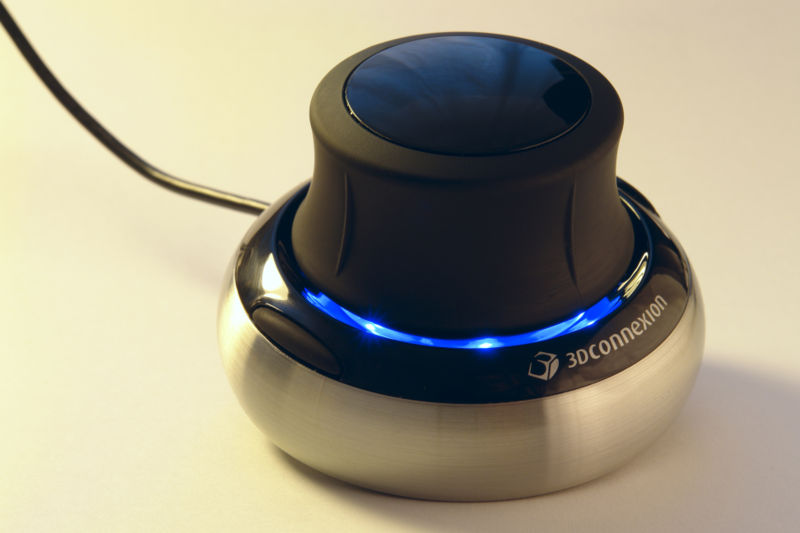
Mouse-like usb input device. $60 academic, $100 commercial. Heavy.
Has 6 degrees of freedom -- 6 numbers reported to program rather than 2 for
mouse. Push in 3 directions (x,y,z) and rotation about 3 axes.
More natural movement of models than using 3-buttons on mouse for rotating,
translating and zooming.
Interesting details.
- Push forward/backward is zoom, unlike mouse where it is y translation.
Very natural.
- "Dominant mode" does only rotation or only translation instead of both
simultaneously (toggle with space navigator button 2).
- Zoom is much nicer than model z-translation with clipping
(toggle with shortcut nz). Allows close in view.
- Two assignable buttons. For example, center models (space nav button 1).
- Can use with mouse in hand docking (shortcut na).
|

Unified Surface Model
Made MSMS molecular surfaces use same type of surface model as volume,
multiscale, surfnet, intersurf, shape command, GRASP surfaces, IMOD surfaces.
Formerly separate code was needed to handle msms surfaces and
volume... surfaces, for example measuring surface area.
New MSMSModel is implemented in Python instead of C++ making it easy to
improve MSMS surfacing.
- Chimera no longer will crash in MSMS surface calculation. Calls a separate
process for calculation.
- Per-atom surface areas (solvent excluded and accessible) are assigned to
atoms.
- Bug fix in MSMS reduced crashing cases from 80/1000 to 2/1000 for
single component surfaces. (All component crashes 180->80.)
Still to come.
- Fallback to single-component surface calculation if all-component fails.
- Analytical area calculation. Currently uses surface triangles.
- Per-residue surface areas.
|
Surface Tracing
|
Can hand trace surfaces by drawing curves or loops that are stitched to
make the surface. Useful for segmenting structures in density maps.
Use "place markers while dragging" mouse mode and the Surfaces panel
in the volume tracer dialog.
Surfaces can be used for masking volume data.
EM tomography analysis done by Jeff Triffo in Manfred Auer lab at LBNL.
Movie.

|
Geometric Shapes
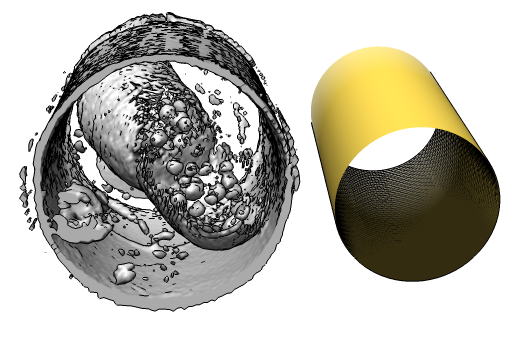
New "shape" command makes surfaces for standard geometric shapes: sphere,
cylinder, icosahedron.
Useful for masking volume data.
Shapes can be resized interactively with resize surface mouse mode.
Example shows dividing pombe cell within a glass pipette imaged by
x-ray tomography. Use cylinder to mask away pipette. Illustration
from Chimera presentation at National Center for X-ray Tomography.
|
Fitting with Simulated Maps

Can calculate a low resolution simulated map from a PDB model with new
"molmap" command.
Useful for fitting and into experimental maps and determining correlation
coefficient of fit.
Fit optimization tool now has option to create simulated map and to report
correlation coefficient as model is moved within map.
Space navigator can be used together with mouse in hand fitting.
One controls overall view point, the other moves just the molecule.
|
Angle Dependent Transparency
Andrew Jewett suggested making transparent surfaces more opaque in places
where they are not face-on.
Improves depth perception. Gives an effect similar to silhouette edges.
Accounts for thickness of a slab along line of sight being greater for
oblique orientations, 1/cos(theta) dependence.
Have only tested idea with a script for a surface in fixed orientation.
Next step is to support realtime update during rotation.
Thick Surfaces
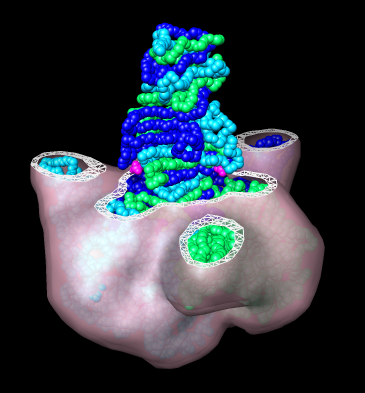
Can turn surfaces into slabs.
A selected surface is made into two surfaces displaced along surface normals.
Done with a script that calls code that implements slab option of mask command.
Useful? Just play'n.
|
Inertia Axes of a Molecule

Inertia ellipsoid representing principal axes and moments about those axes.
Axes and moments are printed to reply log.



